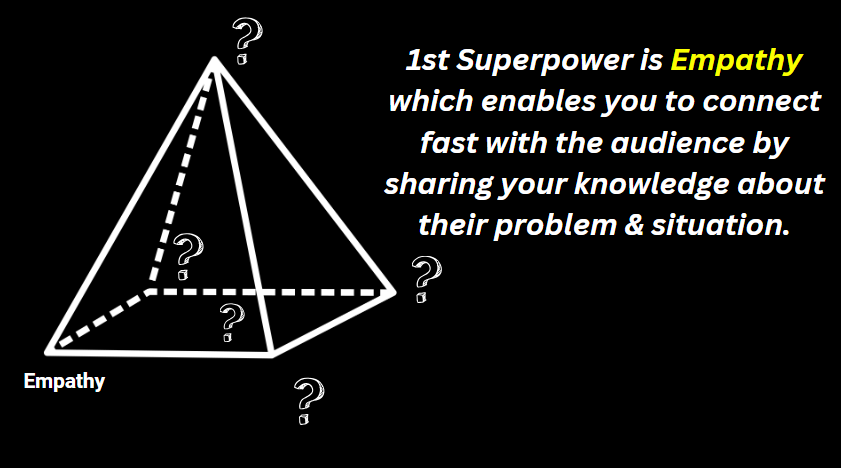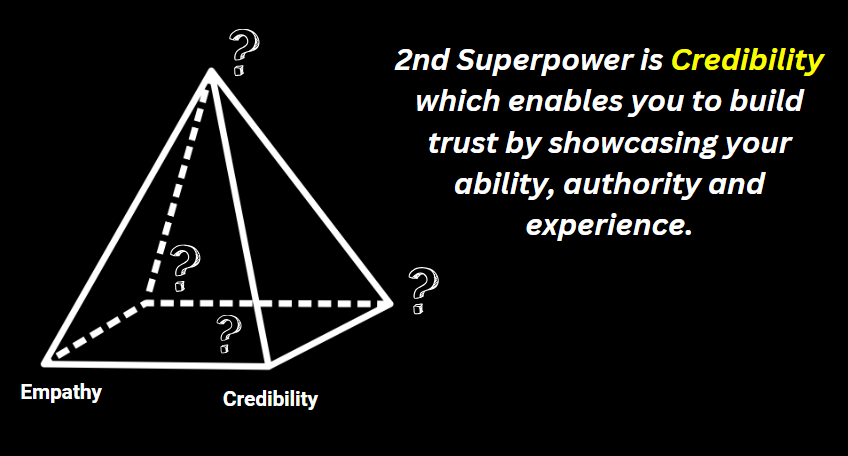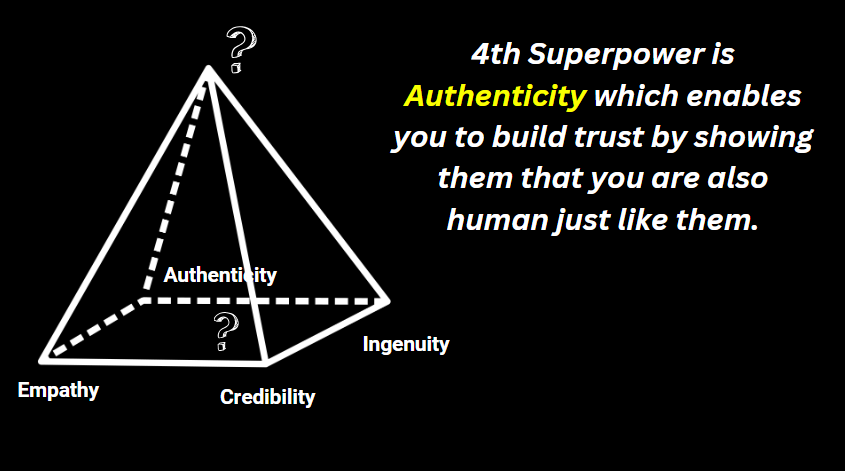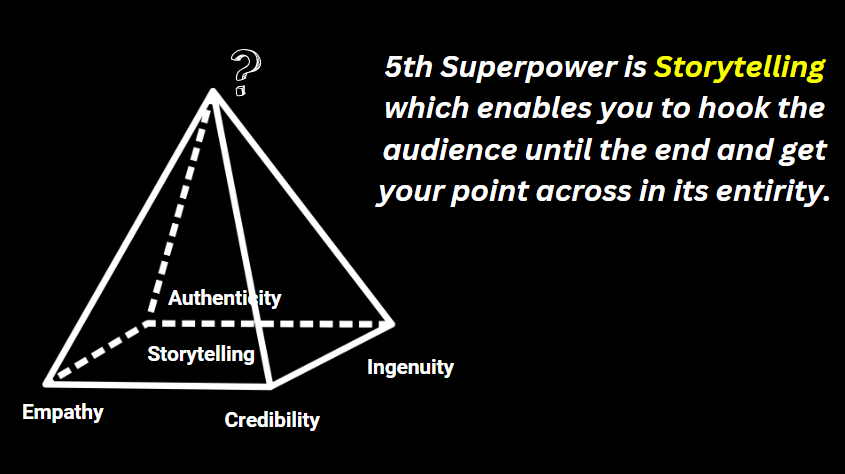Trust Triangle Framework
Uniting the Forces of Persuasion: The Imperative of a Holistic Framework
In the ever-evolving landscape of marketing and communication, the pursuit of persuasion has reached a critical juncture. Traditional tactics, once hailed as the holy grail of influence, are now met with skepticism and resistance from savvy consumers. In this era of information overload and hyper-awareness, brands must adapt or risk becoming obsolete.
Enter the quest for a new paradigm – a framework that transcends the limitations of individual persuasion principles and unites the disparate elements of human connection, psychology, and motivation. This framework isn’t just about tactics; it’s about understanding the intricacies of human behavior and leveraging them to build genuine trust and connection.
Imagine a world where empathy, credibility, ingenuity, authenticity, storytelling, and balance converge seamlessly to form a powerful arsenal of persuasion. Each element contributes to a symphony of influence, resonating with consumers on a deeper level and compelling them to take action.
This is more than just persuasion; it’s a revolution in communication. It’s about forging authentic connections, inspiring meaningful engagement, and ultimately, driving tangible results. In today’s competitive landscape, brands can no longer afford to rely on outdated tactics. It’s time to embrace a holistic approach to persuasion and unlock the full potential of human connection. Welcome to the future of communication.
Why Traditional Persuasion Principles Fall Short
In the annals of marketing lore, Robert Cialdini’s principles of persuasion have long been revered as the gold standard for influencing consumer behavior. Yet, as the digital age ushers in a new era of skepticism and discernment, the efficacy of these traditional tactics is waning.
Consider the principle of scarcity, a cornerstone of Cialdini’s framework. While scarcity once drove frenzied purchasing frenzies, today’s consumers are inundated with artificial scarcity tactics, from limited-time offers to countdown clocks. As author Seth Godin astutely observes in “Purple Cow,” “When just about every product is described as ‘new and improved,’ it’s difficult for consumers to distinguish the genuinely innovative from the merely ‘me-too’.”
Furthermore, the principle of authority, another pillar of Cialdini’s work, is facing mounting scrutiny in an age of misinformation and distrust. As renowned psychologist Adam Grant writes in “Give and Take,” “In a world where trust in institutions is at an all-time low, mere credentials are no longer sufficient to command authority. Consumers demand authenticity and transparency.”
In essence, traditional persuasion principles are no match for the discerning consumer of today. As the digital landscape evolves and consumer expectations shift, brands must adapt their tactics or risk irrelevance. It’s time for a paradigm shift – a holistic approach that acknowledges the complexities of human psychology and fosters genuine connection.

The Evolution of Trust:
Crafting the Unique Trust Triangle Framework
In our relentless pursuit of persuasion mastery, it’s imperative to delve into the very essence of human connection – trust. While a cursory Google search might offer a succinct definition of trust as a firm belief in the reliability, ability, or truth of someone or something, this oversimplified understanding falls short in the realm of effective persuasion. To truly resonate with our audience and ignite action, we must redefine trust through a more nuanced lens, one that reflects the intricacies of human relationships and motivations.
Borrowing insights from thought leaders like Brené Brown and Simon Sinek, we begin to unravel the multifaceted nature of trust. Brown, in her groundbreaking work on vulnerability, underscores the importance of trust in fostering genuine connections. Similarly, Sinek’s exploration of inspirational leadership emphasizes the pivotal role of trust in driving meaningful engagement and collaboration.
Consider, for instance, the dynamics of any relationship. Trust forms the bedrock of this connection, enabling open communication, constructive feedback, and mutual growth. In the corporate world, trust between leaders and employees cultivates a culture of transparency, empowerment, and innovation.
With this refined understanding of trust, we unlock a powerful tool for persuasion. By aligning our communication strategies with this deeper definition of trust, we tap into the core motivations and desires of our audience. Whether crafting compelling marketing campaigns, delivering persuasive presentations, or nurturing personal relationships, trust serves as the linchpin that transforms mere interactions into transformative experiences.
In essence, trust becomes not just a prerequisite for persuasion, but the very foundation upon which authentic connections are built. By embracing this new paradigm, we embark on a journey toward more meaningful, impactful communication, enriching both our professional endeavors and personal relationships alike.
Trust, as now understood, is the strong belief that the person we are building a relationship with has our better interests in mind and is going to act in good faith, which is mutually beneficial both in the short term and in the long term. Two things to note here: Trust is not synonymous with "best interest in mind." As buyers, we acknowledge that sellers have their interests as well. As long as they have our better interest in mind, we're good. Secondly, we expect sellers to consider our short-term and long-term benefits while promoting their product or service to us.
Superpower #1: Empathy – The Key to Trust and Action

Imagine this: you’re in agonizing pain, seeking solace in your trusted doctor’s office. As you begin to describe your symptoms, your doctor interrupts, swiftly listing additional ailments you hadn’t yet mentioned. Moments later, two pills later, your pain dissipates, leaving you wondering if your doctor possesses mystical powers.
This scenario illustrates the profound trust we place in certain individuals, particularly our healthcare providers. It’s this level of trust we aspire to cultivate with our prospects. And the gateway to achieving this is empathy.
Empathy isn’t merely understanding; it’s about making your audience feel deeply heard and comprehended. To wield empathy effectively, meticulous audience definition is paramount. Dive into research, unraveling their pain points, aspirations, and fears. Yet, despite its significance, audience definition often takes a backseat, resulting in generic communication that fails to resonate.
The consequence? Lackluster engagement and tepid conversions across platforms. But fear not, for empathy holds transformative power. When harnessed adeptly, it elevates your communication, allowing you to articulate your prospect’s struggles so vividly that they can’t help but feel understood.
Consider the words of Brené Brown, renowned researcher and author, who said, “Empathy has no script. There is no right way or wrong way to do it. It’s simply listening, holding space, withholding judgment, emotionally connecting, and communicating that incredibly healing message of ‘You’re not alone.'”
Moreover, behavioural experiments, like those conducted by renowned psychologist Daniel Kahneman, reinforce the profound impact of empathy on decision-making. By crafting narratives that evoke empathy, you enable your audience to see themselves within your story, fostering a connection that transcends mere words.
Here are some actionable strategies:
- Define your audience meticulously through thorough research.
- Listen actively and empathetically to your audience’s concerns and experiences.
- Craft narratives that vividly illustrate your audience’s struggles and aspirations.
- Use language that resonates emotionally and connects on a human level.
- Continuously seek feedback and adjust your approach to better empathise with your audience.
In essence, empathy isn't just a buzzword; it's the cornerstone of effective communication. By understanding and empathizing with your audience's journey, you pave the way for trust, engagement, and ultimately, action.
Superpower #2: Credibility – Enhancing Authority and Trust in You as a Guide

While empathy forms the bedrock of effective communication, it’s often insufficient on its own. Merely understanding your audience’s pain points doesn’t guarantee the ability to address them adequately. This is where credibility steps in as the indispensable companion to empathy.
Credibility is the linchpin that demonstrates not only your understanding of the problem but also your capability to solve it. It’s the culmination of knowledge, expertise, and a proven track record of success in tackling similar challenges for others.
However, weaving credibility into your message requires finesse. You must strike a delicate balance between showcasing your accomplishments and expertise without coming across as boastful or insincere. One misstep can jeopardize your credibility and undermine your entire communication strategy.
So, how can you effectively convey credibility without resorting to self-aggrandizement?
Here are some actionable strategies:
- Share Success Stories: Highlight case studies or success stories where you’ve successfully addressed similar challenges for others. Concrete examples of your past accomplishments serve as compelling proof of your capability.
- Leverage Social Proof: Utilize testimonials, reviews, or endorsements from satisfied clients or reputable figures in your industry. Social proof lends credibility by showcasing others’ trust in your expertise and solutions.
- Demonstrate Authority: Position yourself as an authority in your field by sharing valuable insights, thought leadership content, or research findings. Publishing articles, speaking at conferences, or participating in panel discussions can help establish your credibility as a trusted expert.
- Be Transparent: Authenticity breeds credibility. Be transparent about your journey, experiences, and any challenges you’ve encountered along the way. Vulnerability humanizes your brand and fosters trust with your audience.
- Avoid Overpromising: Maintain integrity by refraining from making exaggerated claims or promises that you can’t deliver. Underpromise and overdeliver to exceed your audience’s expectations and solidify your credibility.
By incorporating these strategies into your communication, you not only bolster your credibility but also strengthen the foundation of trust with your audience. Remember, empathy and credibility together form a formidable alliance that paves the way for meaningful connections and persuasive communication.
Superpower 3#: Ingenuity – Unleashing Unique Solutions

In today’s fiercely competitive landscape, empathy and credibility are essential, but they alone may not suffice to set you apart. Amidst a sea of smart competitors capable of demonstrating empathy and credibility, the key to standing out lies in ingenuity.
Ingenuity encompasses the unique value proposition that your product or solution offers, distinguishing it from the competition and sparking excitement among prospects. It’s the element that instills hope and belief in your audience, signaling that you possess something truly innovative that can make a tangible difference in their lives.
However, achieving ingenuity is no small feat. It requires relentless innovation and creativity to develop products or solutions that genuinely disrupt the market and captivate your audience’s imagination. Without empathy and credibility as its foundation, ingenuity risks feeling contrived or gimmicky, undermining trust rather than bolstering it.
So, how can you infuse ingenuity into your offerings and communication effectively?
Here are some actionable strategies:
- Identify Unmet Needs: Conduct thorough market research to identify gaps or pain points that existing solutions fail to address adequately. Innovate with the aim of fulfilling these unmet needs in a way that resonates with your audience.
- Seek Expert Guidance: Consider consulting with industry experts or innovation consultants who can offer fresh perspectives and strategic insights to help you refine your product or service. Collaborate with professionals who specialize in product design, user experience, or marketing to optimize your ingenuity.
- Look Inwards and Ideate from Your Journey: Reflect on your personal experiences, expertise, and journey to unearth unique insights and perspectives that only you can bring to the table. Consider how your individual background, skills, and passions can inform innovative solutions that resonate deeply with your audience. By tapping into your own story and embracing authenticity, you can uncover hidden gems of ingenuity that set your offerings apart from the competition.
- Iterate and Refine: Embrace a mindset of continuous improvement, iterating on your product or service based on feedback from customers and market trends. Strive to evolve and adapt your offerings to remain relevant and competitive in a rapidly changing landscape.
By integrating ingenuity into your products, services, and communication strategies, you not only differentiate yourself from competitors but also unlock the potential to command premium pricing and cultivate a loyal customer base. While challenging, the pursuit of ingenuity is a worthwhile endeavor that can propel your business to new heights of success and innovation.
Superpower #4: Authenticity – Building Trust Through Transparency

In the dynamic landscape of trust-building, authenticity emerges as a powerful force, capable of forging genuine connections and fostering unwavering trust. Authenticity transcends mere transactional interactions, allowing individuals to resonate with their audience on a profound level. Consider the remarkable journey of Brené Brown, a renowned researcher and author, whose TED Talk on vulnerability propelled her to global recognition. By candidly sharing her personal struggles and insecurities, Brown not only cultivated authenticity but also sparked a worldwide conversation on the power of vulnerability in fostering meaningful connections.
Furthermore, in the corporate realm, companies like Patagonia have demonstrated the transformative potential of authenticity in brand communication. Through initiatives like their “Worn Wear” campaign, Patagonia not only encouraged sustainable consumption but also showcased their commitment to transparency and environmental responsibility. This authenticity resonated deeply with their audience, establishing a loyal customer base rooted in shared values and trust.
Authenticity isn’t confined to grand gestures or public platforms; it permeates every interaction, no matter how small. Whether it’s a heartfelt Instagram post from a local artisan sharing the story behind their craft or a candid blog post from a CEO addressing challenges within their company, authenticity humanizes brands and cultivates genuine connections with their audience.
Actions to Cultivate Authenticity:
- Share Personal Stories: Communicate genuine anecdotes and experiences that highlight your journey and values.
- Be Transparent: Maintain honesty and openness in all interactions, even when addressing difficult topics or setbacks.
- Show Vulnerability: Demonstrate humility by acknowledging mistakes and learning experiences, showcasing that growth is an ongoing process.
- Align Actions with Values: Ensure consistency between your words and deeds, reflecting your authentic beliefs and principles.
- Listen and Respond: Actively engage with your audience, acknowledging their feedback and concerns with sincerity and empathy.
However, it's imperative to strike a delicate balance to maintain credibility and trustworthiness. Authenticity should be conveyed in a manner that resonates with the audience without compromising one's expertise or professionalism.
Superpower #5: Storytelling – Captivating Audiences Through Narrative

As the cornerstone of the trust triangle, storytelling serves as the conduit through which the other superpowers are channeled, allowing for a seamless connection between communicator and audience. Picture this: You’ve meticulously crafted a compelling presentation, weaving together empathy, credibility, ingenuity, and authenticity. Yet, midway through, you sense your audience drifting, their attention slipping away like sand through your fingers. Herein lies the pivotal role of storytelling – the fifth superpower essential for holding sway over your audience’s focus and emotions.
Storytelling transcends age and demographics, captivating both children and adults alike. It’s the art of taking your audience on a journey, guiding them through the landscape of your narrative with skillful precision. Whether you’re addressing investors, customers, or colleagues, the right story has the unparalleled ability to evoke empathy, bolster credibility, showcase ingenuity, and underscore authenticity.
However, storytelling is not a skill reserved for literary virtuosos or seasoned authors. With the right guidance and practice, anyone can harness its transformative power. Take, for instance, the 7C framework, a tool designed to help individuals transform mundane experiences into compelling narratives. Through structured practice and constructive feedback, participants in various workshops and masterminds have honed their storytelling abilities, enriching their communication and fostering deeper connections with their audience.
- Practice crafting compelling narratives using different frameworks.
- Share personal experiences and anecdotes to make your message more relatable.
- Seek feedback on your storytelling techniques to refine and improve your skills.
- Experiment with different storytelling styles and formats to find what resonates best with your audience.
- Incorporate storytelling into various communication channels, such as presentations, social media posts, and conversations, to enhance engagement and connection.
In essence, storytelling is a skill that can be cultivated and refined over time. By embracing different frameworks and committing to regular practice, communicators of all stripes can elevate their storytelling prowess, enriching their interactions and unlocking new realms of engagement and trust with their audience.
Superpower #6: Crafting Communication for Maximum Trust

In the realm of trust-building through communication, we encounter a delicate yet powerful art akin to crafting a favorite dish. Just as the perfect chocolate vegan cake demands precise ingredient proportions and timings, so does effective communication require a harmonious blend of elements.
Imagine each communication as a culinary masterpiece, with empathy, credibility, ingenuity, authenticity, and storytelling as its core ingredients. The challenge lies not just in incorporating these elements but in orchestrating them with finesse, ensuring each contributes optimally to the desired outcome.
Our goal in communication mirrors that of a chef: to maximize value for our audience. This involves striking the right balance, as overemphasis on one aspect can disrupt the delicate harmony. Just as too much sugar can ruin a cake, an excess of storytelling or empathy can dilute the impact of our message.
To navigate this challenge, we must be mindful of proportion and timing, ensuring each element is integrated seamlessly. Neglecting any component risks leaving our audience unsatisfied, while overindulgence may overwhelm them.
In practice, this means tailoring our communication to suit the preferences and needs of our audience, recognizing that each situation demands a unique blend of ingredients. By mastering this art of balance, we harness the full potential of communication as a superpower in cultivating trust and forging lasting connections.
Elevating Communication to a Trust-Building Superpower
In the journey of exploring the intricate dynamics of communication, we’ve uncovered the transformative potential it holds in fostering trust and connection. From empathy to storytelling, each element plays a vital role in crafting compelling narratives that resonate with our audience.
Through empathy, we bridge the gap between understanding and action, forging authentic connections that transcend mere words. Credibility lends authority to our message, instilling confidence in our audience that we possess the knowledge and experience to deliver on our promises.
Ingenuity sets us apart from the competition, offering unique solutions that captivate and inspire. Authenticity grounds us in our humanity, fostering relatability and trust by sharing our struggles and triumphs openly and honestly.
Finally, storytelling weaves these elements into a tapestry of engagement, captivating our audience’s attention and guiding them on a journey of discovery and connection. Together, these six superpowers form the cornerstone of effective communication, empowering us to build trust, foster connection, and drive meaningful change.
As we harness the collective power of these elements, let us remember the importance of balance and nuance, recognizing that true mastery lies in the art of blending them harmoniously to create communication that resonates deeply with our audience. In doing so, we unlock the full potential of communication as a superpower, capable of transforming relationships, driving action, and shaping the world around us.
Share This Post

Why Personal Branding Online Matters?
Does successful people create personal brands or personal branding and more importantly, personal branding online leads to far bigger success. I prove it here that it is the latter. Read on.
What’s significantly more important than Happiness?
At first glance, it seems like everyone in the world is after happiness one way or another. Our definition of what constitute happiness and the



